Allstate 2015 Annual Report Download - page 207
Download and view the complete annual report
Please find page 207 of the 2015 Allstate annual report below. You can navigate through the pages in the report by either clicking on the pages listed below, or by using the keyword search tool below to find specific information within the annual report.-
 1
1 -
 2
2 -
 3
3 -
 4
4 -
 5
5 -
 6
6 -
 7
7 -
 8
8 -
 9
9 -
 10
10 -
 11
11 -
 12
12 -
 13
13 -
 14
14 -
 15
15 -
 16
16 -
 17
17 -
 18
18 -
 19
19 -
 20
20 -
 21
21 -
 22
22 -
 23
23 -
 24
24 -
 25
25 -
 26
26 -
 27
27 -
 28
28 -
 29
29 -
 30
30 -
 31
31 -
 32
32 -
 33
33 -
 34
34 -
 35
35 -
 36
36 -
 37
37 -
 38
38 -
 39
39 -
 40
40 -
 41
41 -
 42
42 -
 43
43 -
 44
44 -
 45
45 -
 46
46 -
 47
47 -
 48
48 -
 49
49 -
 50
50 -
 51
51 -
 52
52 -
 53
53 -
 54
54 -
 55
55 -
 56
56 -
 57
57 -
 58
58 -
 59
59 -
 60
60 -
 61
61 -
 62
62 -
 63
63 -
 64
64 -
 65
65 -
 66
66 -
 67
67 -
 68
68 -
 69
69 -
 70
70 -
 71
71 -
 72
72 -
 73
73 -
 74
74 -
 75
75 -
 76
76 -
 77
77 -
 78
78 -
 79
79 -
 80
80 -
 81
81 -
 82
82 -
 83
83 -
 84
84 -
 85
85 -
 86
86 -
 87
87 -
 88
88 -
 89
89 -
 90
90 -
 91
91 -
 92
92 -
 93
93 -
 94
94 -
 95
95 -
 96
96 -
 97
97 -
 98
98 -
 99
99 -
 100
100 -
 101
101 -
 102
102 -
 103
103 -
 104
104 -
 105
105 -
 106
106 -
 107
107 -
 108
108 -
 109
109 -
 110
110 -
 111
111 -
 112
112 -
 113
113 -
 114
114 -
 115
115 -
 116
116 -
 117
117 -
 118
118 -
 119
119 -
 120
120 -
 121
121 -
 122
122 -
 123
123 -
 124
124 -
 125
125 -
 126
126 -
 127
127 -
 128
128 -
 129
129 -
 130
130 -
 131
131 -
 132
132 -
 133
133 -
 134
134 -
 135
135 -
 136
136 -
 137
137 -
 138
138 -
 139
139 -
 140
140 -
 141
141 -
 142
142 -
 143
143 -
 144
144 -
 145
145 -
 146
146 -
 147
147 -
 148
148 -
 149
149 -
 150
150 -
 151
151 -
 152
152 -
 153
153 -
 154
154 -
 155
155 -
 156
156 -
 157
157 -
 158
158 -
 159
159 -
 160
160 -
 161
161 -
 162
162 -
 163
163 -
 164
164 -
 165
165 -
 166
166 -
 167
167 -
 168
168 -
 169
169 -
 170
170 -
 171
171 -
 172
172 -
 173
173 -
 174
174 -
 175
175 -
 176
176 -
 177
177 -
 178
178 -
 179
179 -
 180
180 -
 181
181 -
 182
182 -
 183
183 -
 184
184 -
 185
185 -
 186
186 -
 187
187 -
 188
188 -
 189
189 -
 190
190 -
 191
191 -
 192
192 -
 193
193 -
 194
194 -
 195
195 -
 196
196 -
 197
197 -
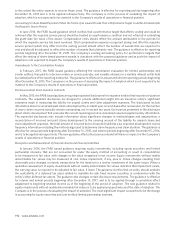 198
198 -
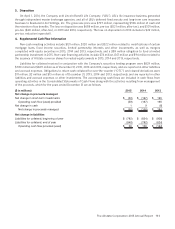 199
199 -
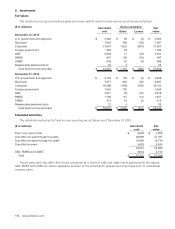 200
200 -
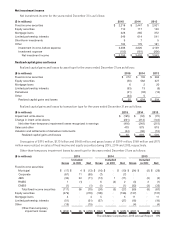 201
201 -
 202
202 -
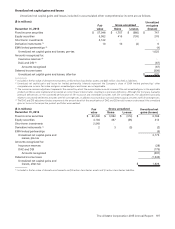 203
203 -
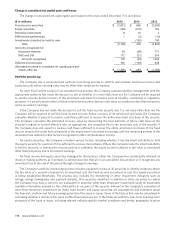 204
204 -
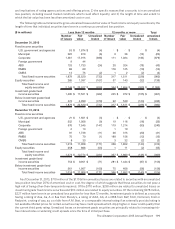 205
205 -
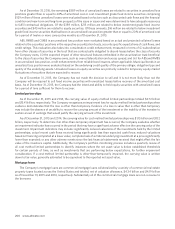 206
206 -
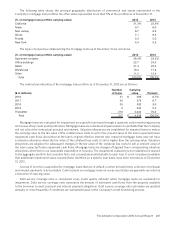 207
207 -
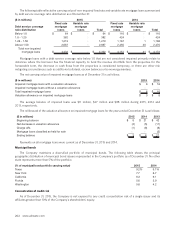 208
208 -
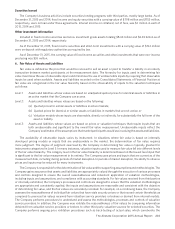 209
209 -
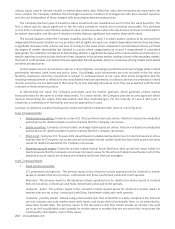 210
210 -
 211
211 -
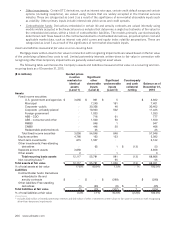 212
212 -
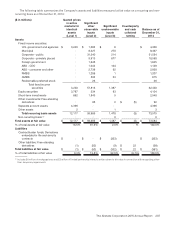 213
213 -
 214
214 -
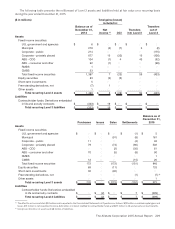 215
215 -
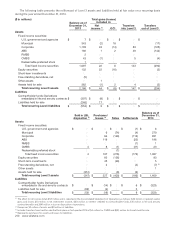 216
216 -
 217
217 -
 218
218 -
 219
219 -
 220
220 -
 221
221 -
 222
222 -
 223
223 -
 224
224 -
 225
225 -
 226
226 -
 227
227 -
 228
228 -
 229
229 -
 230
230 -
 231
231 -
 232
232 -
 233
233 -
 234
234 -
 235
235 -
 236
236 -
 237
237 -
 238
238 -
 239
239 -
 240
240 -
 241
241 -
 242
242 -
 243
243 -
 244
244 -
 245
245 -
 246
246 -
 247
247 -
 248
248 -
 249
249 -
 250
250 -
 251
251 -
 252
252 -
 253
253 -
 254
254 -
 255
255 -
 256
256 -
 257
257 -
 258
258 -
 259
259 -
 260
260 -
 261
261 -
 262
262 -
 263
263 -
 264
264 -
 265
265 -
 266
266 -
 267
267 -
 268
268 -
 269
269 -
 270
270 -
 271
271 -
 272
272
 |
 |

The Allstate Corporation 2015 Annual Report 201
The following table shows the principal geographic distribution of commercial real estate represented in the
Company’s mortgage loan portfolio. No other state represented more than 5% of the portfolio as of December 31.
(% of mortgage loan portfolio carrying value) 2015 2014
California 21.3% 23.9%
Texas 9.7 8.0
New Jersey 8.7 8.0
Illinois 7.1 9.4
Florida 5.3 5.0
New York 4.4 5.9
The types of properties collateralizing the mortgage loans as of December 31 are as follows:
(% of mortgage loan portfolio carrying value) 2015 2014
Apartment complex 26.4% 23.3%
Office buildings 22.7 24.3
Retail 21.3 22.2
Warehouse 18.4 17.8
Other 11.2 12.4
Total 100.0% 100.0%
The contractual maturities of the mortgage loan portfolio as of December 31, 2015 are as follows:
($ in millions)
Number
of loans
Carrying
value Percent
2016 31 $ 289 6.7%
2017 34 379 8.7
2018 33 392 9.0
2019 9 234 5.4
Thereafter 210 3,044 70.2
Total 317 $ 4,338 100.0%
Mortgage loans are evaluated for impairment on a specific loan basis through a quarterly credit monitoring process
and review of key credit quality indicators. Mortgage loans are considered impaired when it is probable that the Company
will not collect the contractual principal and interest. Valuation allowances are established for impaired loans to reduce
the carrying value to the fair value of the collateral less costs to sell or the present value of the loan’s expected future
repayment cash flows discounted at the loan’s original effective interest rate. Impaired mortgage loans may not have
a valuation allowance when the fair value of the collateral less costs to sell is higher than the carrying value. Valuation
allowances are adjusted for subsequent changes in the fair value of the collateral less costs to sell or present value of
the loan’s expected future repayment cash flows. Mortgage loans are charged off against their corresponding valuation
allowances when there is no reasonable expectation of recovery. The impairment evaluation is non-statistical in respect
to the aggregate portfolio but considers facts and circumstances attributable to each loan. It is not considered probable
that additional impairment losses, beyond those identified on a specific loan basis, have been incurred as of December
31, 2015.
Accrual of income is suspended for mortgage loans that are in default or when full and timely collection of principal
and interest payments is not probable. Cash receipts on mortgage loans on nonaccrual status are generally recorded as
a reduction of carrying value.
Debt service coverage ratio is considered a key credit quality indicator when mortgage loans are evaluated for
impairment. Debt service coverage ratio represents the amount of estimated cash flows from the property available
to the borrower to meet principal and interest payment obligations. Debt service coverage ratio estimates are updated
annually or more frequently if conditions are warranted based on the Company’s credit monitoring process.
